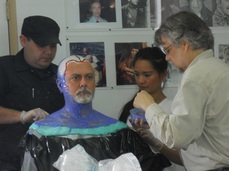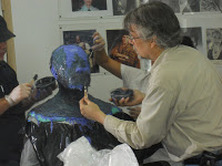Being a record of my journey as I undertake a new role that, unlike many others I have played, fills me with a sense of immense challenge and a promise of growth, both as an actor and a seeker.
I sit in a chair in the costume shop, and I suddenly find it a little hard to breath. I am almost overwhelmed with sadness, a feeling of isolation, and a distant sense of a deeply buried rage. I’ve come down to South Coast Rep for a fitting with Amy Hutto and Laurie Donati, who are designing and building what I am calling “my body.” I am calling it my body because, as I mentioned in an earlier post, I don’t want to call it by the more common industry name. I will inhabit it this body to become Charlie in The Whale. To call it by its common name would be to separate myself from myself. I want to be as integrated with this new body as I can possibly be for the next two months.
Laurie and Amy have done the preliminary work on the innermost layer of my body, which is made from Powernet, a spandex fabric which resembles a very thick, strong stocking material. It needs to have a snug fit so that it can anchor the rest of my body. Amy and Laurie are making sure it fits properly before they begin the extensive work of attaching the huge amount of necessary foam and padding. First I don a cotton onesie that covers me from just below the knees to just past my elbows. This can be washed between each performance, which will make life more pleasant, especially for anyone having to spend time near me. This body can only be washed once a week, since it will take two days to dry. On top of the onesie goes a specially designed vest worn by performers playing characters at theme parks in hot weather. It has four large pockets running top to bottom, two on the front and two on the back. The pockets hold large packs of a special gel. The packs are kept in the freezer between shows, and will go into the vest to keep me from overheating during performances. On top of the onesie and the vest goes the innermost layer of my body. Once I have it on, Laurie measures and pins. When that’s done, she and Amy ask if I want to try on a prosthetic suit that they made for another actor in a different play. It’s about a quarter of the size that my body will become, but they say it should give me a preliminary idea of what it will feel like. They help me into it, and I stand for a few moments, getting a sense of this new bulk and shape. Then the feelings begin to flood in. I sit, and hold back the tears.
There’s has been a flurry of other activity this past two weeks as we gear up to start rehearsal. There’s an audition session where I read with the actors called back for the roles of my daughter, my best friend, and my ex-wife. I am not part of the casting decision process, but the next day I speak with Joanne DeNaut, SCR casting director, to find out the results. The actors cast in each of the three roles were the ones that I would have chosen, so I’m feeling very confident about the team being assembled. In addition I have to keep up with my reading list, which is growing instead of getting smaller. Song of Myself has been added. I’m still working my way through Moby Dickalong with the rest of the material, and on some wild tangent I found myself reading The Rhyme of the Ancient Mariner. Don’t ask me why. I also I found time to read the play again, start to finish, in one sitting, since that is how it is supposed to be experienced, all of a piece.
Laurie and Amy have done the preliminary work on the innermost layer of my body, which is made from Powernet, a spandex fabric which resembles a very thick, strong stocking material. It needs to have a snug fit so that it can anchor the rest of my body. Amy and Laurie are making sure it fits properly before they begin the extensive work of attaching the huge amount of necessary foam and padding. First I don a cotton onesie that covers me from just below the knees to just past my elbows. This can be washed between each performance, which will make life more pleasant, especially for anyone having to spend time near me. This body can only be washed once a week, since it will take two days to dry. On top of the onesie goes a specially designed vest worn by performers playing characters at theme parks in hot weather. It has four large pockets running top to bottom, two on the front and two on the back. The pockets hold large packs of a special gel. The packs are kept in the freezer between shows, and will go into the vest to keep me from overheating during performances. On top of the onesie and the vest goes the innermost layer of my body. Once I have it on, Laurie measures and pins. When that’s done, she and Amy ask if I want to try on a prosthetic suit that they made for another actor in a different play. It’s about a quarter of the size that my body will become, but they say it should give me a preliminary idea of what it will feel like. They help me into it, and I stand for a few moments, getting a sense of this new bulk and shape. Then the feelings begin to flood in. I sit, and hold back the tears.
There’s has been a flurry of other activity this past two weeks as we gear up to start rehearsal. There’s an audition session where I read with the actors called back for the roles of my daughter, my best friend, and my ex-wife. I am not part of the casting decision process, but the next day I speak with Joanne DeNaut, SCR casting director, to find out the results. The actors cast in each of the three roles were the ones that I would have chosen, so I’m feeling very confident about the team being assembled. In addition I have to keep up with my reading list, which is growing instead of getting smaller. Song of Myself has been added. I’m still working my way through Moby Dickalong with the rest of the material, and on some wild tangent I found myself reading The Rhyme of the Ancient Mariner. Don’t ask me why. I also I found time to read the play again, start to finish, in one sitting, since that is how it is supposed to be experienced, all of a piece.
 Kevin Haney and his team.
Kevin Haney and his team. Another fascinating and crucial aspect of my transformation is being handled by Kevin Haney, the man responsible for turning Martin Short into Jiminy Glick, as well as many other projects. I met him at his lab last week, and his team spent two hours taking a life-cast of my head, neck, and shoulders for use in building my neck and facial prosthetics. We’re not going to reveal anything of the full transformation prior to the opening of the production, but without giving anything away I can include some photos here of that first day in the lab, and the resulting life-cast.
 Completely covered.
Completely covered. At the lab, they clothe me in a large garbage bag, shave my chest, shoulders and back, (yeah, middle-age is so attractive), put a bald cap on me, and slather all exposed skin with cholesterol, which will stop the casting material from sticking to me. Then they begin to trowel liquid goo over me from the top down, covering everything but my nostrils. Before beginning the process there was much concern that I might be claustrophobic, and they tell me that they’ll be checking in with me, that I have to give them a thumbs up or thumbs down. Apparently some people freak out when they’re encased in the quickly hardening goop. I assure them that I’m actually the opposite of claustrophobic. In fact, at one point in the operation, I cause some consternation to the team because I stop responding to their queries. The problem: I have fallen asleep.
 Nap time.
Nap time. When the team is done with the layers of goop, they cover it in quick-setting plaster bandages, the kind used to make a cast for a broken limb. It will act as a casement to hold the flimsy-floppy rubber mold when they use it to make the bust, or positive, that they will use to build the prosthetics. That’s when things get interesting. I thought plaster dries. But it doesn’t. It hardens as a result of a chemical reaction. And as everyone knows, chemical reactions generate heat. No one has told me this, and towards the end of the session it starts to heat up, very quickly, inside my cozy little head case. I start to wonder just how much and how quickly the heat will increase. But I trust Kevin and his cohorts, and before my brain is baked, they pull off the plaster cast, and cut off the rest of the mold. The whole thing takes two hours, with only about forty-five minutes in the dark.
 Me and my head.
Me and my head. The next day I return to the lab, and get to pose with my bust. It’s strange feeling, to look at this replica of me. At first I’m a little disoriented, thinking there’s something off with the image. Then I realize that I’m most used to seeing my reflection in the mirror. Now it’s reversed. Or not, depending on how you look at it. I’m back at the lab again a few days later to watch as Kevin sculpts layers and folds onto my life-cast, transforming it into an image of what my neck and face would look like with an additional 475 pounds on my frame. It is shocking to see, but also fascinating, and I return to the lab often over the next several days to watch as the process continues, and as his assistants work on other elements of the piece, experimenting with different materials under Kevin’s direction. Making a piece this realistic for a stage production is a challenge. We won’t be able to call “cut,” and have a team there for touchups, and so Kevin is experimenting with some new materials, to give the prosthetics the durability they will need for the run, while still having the enough flexibility for necessary movement and facial expression.
 The finished bust.
The finished bust. And now, after awaiting the day with much anticipation, rehearsals will start tomorrow. Never before have I had a role that required this degree of preparation even before rehearsals start. It has been in large part solitary work, and I am looking forward to the camaraderie of the rehearsal hall. My next report will be from the front, after we’ve started rehearsal, or as Uta Hagen liked to call it, die probe, from the German word for rehearsal, with its roots in probe, or attempt. That’s where we will push, poke and prod the text, playing with each other in order to discover the hidden meanings and undercurrents of the events and relationships. Like medical students dissecting a body in anatomy class, we will pull the play apart, so that we can learn its intricacies. But unlike medical students, when we are done with our work, we will put everything back together, breath new life into the text, and The Whale will come alive.
 RSS Feed
RSS Feed